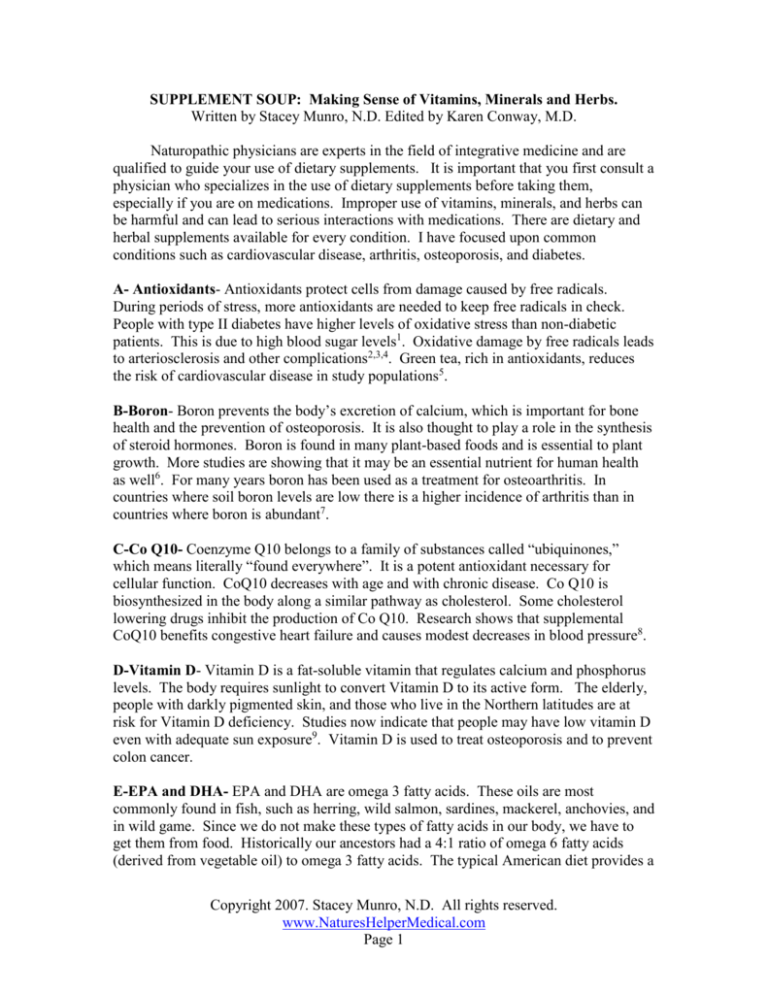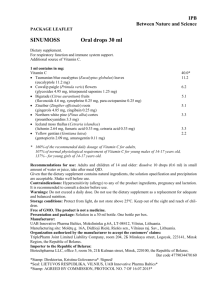
SUPPLEMENT SOUP: Making Sense of Vitamins, Minerals and Herbs.
Written by Stacey Munro, N.D. Edited by Karen Conway, M.D.
Naturopathic physicians are experts in the field of integrative medicine and are
qualified to guide your use of dietary supplements. It is important that you first consult a
physician who specializes in the use of dietary supplements before taking them,
especially if you are on medications. Improper use of vitamins, minerals, and herbs can
be harmful and can lead to serious interactions with medications. There are dietary and
herbal supplements available for every condition. I have focused upon common
conditions such as cardiovascular disease, arthritis, osteoporosis, and diabetes.
A- Antioxidants- Antioxidants protect cells from damage caused by free radicals.
During periods of stress, more antioxidants are needed to keep free radicals in check.
People with type II diabetes have higher levels of oxidative stress than non-diabetic
patients. This is due to high blood sugar levels1. Oxidative damage by free radicals leads
to arteriosclerosis and other complications2,3,4. Green tea, rich in antioxidants, reduces
the risk of cardiovascular disease in study populations5.
B-Boron- Boron prevents the body’s excretion of calcium, which is important for bone
health and the prevention of osteoporosis. It is also thought to play a role in the synthesis
of steroid hormones. Boron is found in many plant-based foods and is essential to plant
growth. More studies are showing that it may be an essential nutrient for human health
as well6. For many years boron has been used as a treatment for osteoarthritis. In
countries where soil boron levels are low there is a higher incidence of arthritis than in
countries where boron is abundant7.
C-Co Q10- Coenzyme Q10 belongs to a family of substances called “ubiquinones,”
which means literally “found everywhere”. It is a potent antioxidant necessary for
cellular function. CoQ10 decreases with age and with chronic disease. Co Q10 is
biosynthesized in the body along a similar pathway as cholesterol. Some cholesterol
lowering drugs inhibit the production of Co Q10. Research shows that supplemental
CoQ10 benefits congestive heart failure and causes modest decreases in blood pressure8.
D-Vitamin D- Vitamin D is a fat-soluble vitamin that regulates calcium and phosphorus
levels. The body requires sunlight to convert Vitamin D to its active form. The elderly,
people with darkly pigmented skin, and those who live in the Northern latitudes are at
risk for Vitamin D deficiency. Studies now indicate that people may have low vitamin D
even with adequate sun exposure9. Vitamin D is used to treat osteoporosis and to prevent
colon cancer.
E-EPA and DHA- EPA and DHA are omega 3 fatty acids. These oils are most
commonly found in fish, such as herring, wild salmon, sardines, mackerel, anchovies, and
in wild game. Since we do not make these types of fatty acids in our body, we have to
get them from food. Historically our ancestors had a 4:1 ratio of omega 6 fatty acids
(derived from vegetable oil) to omega 3 fatty acids. The typical American diet provides a
Copyright 2007. Stacey Munro, N.D. All rights reserved.
www.NaturesHelperMedical.com
Page 1
20:1 ratio. EPA and DHA supplements are used for heart disease, high cholesterol,
arthritis, asthma, skin disorders, depression, and bipolar disorder.
G- GTF Chromium- Glucose tolerance factor (GTF) chromium is a biologically active
form of chromium found in brewer’s yeast. The standard American diet (SAD) of
processed foods is deficient in chromium. Chromium deficiency leads to impaired lipid
and glucose metabolism, known risk factors for cardiovascular disease and type II
diabetes. Studies show that chromium levels in patients with coronary artery disease are
much lower than in normal subjects10.
H-Hawthorn Berry- In the middle ages it hung from doorways to prevent evil spirits.
Hawthorn berry contains antioxidant flavinoid compounds. Hawthorne is thought to have
both physical and emotional effect on the heart. Physically, it helps blood pressure by
relaxing arterial tone and it causes the heart to beat more vigorously11.
K- Vitamin K- Vitamin K is involved in blood coagulation. It is abundant in leafy green
vegetables. Research that a consistent dose of Vitamin K helps to stabilize the bleeding
times of patients on Warfarin, a blood thinner12. Adequate vitamin K in conjunction with
vitamin D prevents arterial calcification and maintains bone health13.
M-Magnesium- Magnesium is crucial for 300 biochemical reactions in the body.
Deficiency may cause insulin resistance, a precursor to type II diabetes, and high blood
pressure14. Magnesium is often deficient in the standard American diet. Nuts and whole
grains are good sources of dietary magnesium, as are beans, dark green vegetables, fish
and meat. It can be used for muscle tension, headaches, and constipation.
N-Niacin- Niacin is one of the best therapies to raise low levels of HDL cholesterol,
which is a risk factor for heart attack. It is often used in combination with other
cholesterol lowering agents for optimal results15. Treatment with therapeutic doses of
niacin may cause uncomfortable skin “flushing” and damage the liver. It is important to
be monitored by a physician while taking niacin.
S-SAMe (S-adenosyl-l-methionine)- SAMe is an important compound in over 40
essential biochemical reactions in the body. It may help to ease depression, and to lower
levels of homocysteine, which is a risk factor for cardiovascular disease16. SAMe is also
used to treat liver cirrhosis and osteoarthritis.
There are many dietary supplements available on the market today. Research is
increasing as the public demand for information expands. As a naturopathic physician I
facilitate effective treatments for patients and their specific conditions.
Copyright 2007. Stacey Munro, N.D. All rights reserved.
www.NaturesHelperMedical.com
Page 2
References:
1Ceriello A. Post-Prandial Hyperglycemia and Diabetic Complications. Diabetes.
2005;54(1):1-7
2Shahab A. Why does diabetes mellitus increase the risk of cardiovascular disease? Acta
Med Indones. 2006 Jan-Mar;38(1):33-41.
3Calles-Escandon J, Cipolla M. Endocri Rev. Diabetes and endothelial dysfunction: a
clinical perspective. 2001 Feb;22(1):36-52.
4Wright E Jr, Scism-Bacon JL, Glass LC. Oxidative stress in type 2 diabetes: the role of
fasting and postprandial glycaemia. Int J Clin Pract. 2006 Mar;60(3):308-14.
5Basu A, Lucas EA. Mechanisms and effects of green tea on cardiovascular health. Nutr
Rev. 2007 Aug;65(8 Pt 1):361-75.
6Devirian TA, Volpe SL. The physiological effects of dietary boron. Crit Rev Sci Nutr.
2003;43(2):219-31.
7Newnham RE. Essentiality of boron for healthy bones and joints. Environ Health
Perspect. 1994 Nov;102 Suppl 7:83-5.
8Sarter B. Coenzyme Q10 and cardiovascular disease: a review. J Cardiovasc Nurse.
2002 Jul;16(4):9-20.
9Binkley N, Novotny R, et. al. Low vitamin D status despite abundant sun exposure. J
Clin Endocrinol Metab. 2007;92:2130-2135.
10Siminof M. Chromium deficiency and cardiovascular risk. Cardiovasc Res. 1984
Oct;18(10):591-6.
11Rigelsky JM, Sweet BV. Hawthorn: pharmacology and therapeutic uses. Am J Health
Syst Pharm. 2002 Mar 1;59(5):417-22.
12Reese AM, Farnet LE, et. al. Low-dose vitamin K to augment anticoagulation control.
Pharmacotherapy. 2005 Dec;25(12):1746-51.
13Adams J, Pepping J. Vitamin K in the Treatment and Prevention of Osteoporosis and
Arterial Calcification. Am J Health-Syst Pharm. 2005;62(15):1574-1581.
14Barbagallo M, Dominguez LJ, Resnick LM. Magnesium metabolism in hypertension
and type 2 diabetes mellitus. Am J Ther. 2007 Jul-Aug;14(4):375-85.
15Miller M. Niacin as a component of combination therapy for dyslipidemia. Mayo Clin
Proc. 2003 Jun;78(6):735-42.
16Gören JL, Stoll AL, et. al. Bioavailability and lack of toxicity of S-adenosyl-Lmethionine (SAMe) in humans. Pharmacotherapy. 2004 Nov;24(11):1501-7.
Copyright 2007. Stacey Munro, N.D. All rights reserved.
www.NaturesHelperMedical.com
Page 3








